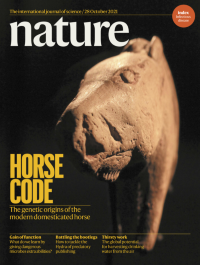Volume 598
-
No. 7882 28 October 2021
Horse codeThe cover shows one of the three Duruthy horses, sculptures found in Sorde-l’Abbaye, France, that date back to the Middle Magdalenian around 17,000 years ago. The genetic lineage for domesticated horses is unclear, and the equine ancestors of modern domestic horses are unknown. In this week’s issue, Ludovic Orlando and his colleagues present DNA analysis of 273 ancient horses from across Eurasia. Using this information, the researchers have identified a centre of domestication in the lower Don-Volga region, now in Russia, after around 2700 BC. Their data suggest that horseback riding and the use of war chariots supported the spread of these newly domesticated horses so that within some 500 years, this horse breed had replaced all previous local horse populations across Eurasia.
Nature Index
-
No. 7881 21 October 2021
Climate clean-upThe cover shows a coal field and open-cast mining near Ordos. With the COP 26 UN Climate Change Conference set to begin in Glasgow, UK, on 31 October, all eyes are focused on whether nations can agree on how to advance the faltering fight against the effects of climate change. In this week’s issue, Nature looks at how well the various efforts are working — and what more needs to be done.
-
No. 7880 14 October 2021
Protein misfoldsThe protein tau is believed to stabilize the skeleton that shapes nerve cells, but in neurodegenerative diseases known as tauopathies, tau misfolds and stacks together to form filaments. In this week’s issue, Sjors Scheres, Michel Goedert and their colleagues build on their previous work identifying different folds of tau filaments present in conditions such as Alzheimer’s disease. They reveal four additional folds relating to specific diseases, including progressive supranuclear palsy and argyrophilic grain disease. The researchers then use the various folds to determine a structure-based hierarchical classification of tauopathies. This classification complements clinical diagnosis and post-mortem neuropathology, and can be used to identify new entities. The cover image shows some of the different tau filaments that are so far correlated with specific diseases.
Career Guide
-
No. 7879 7 October 2021
Brain censusLaunched four years ago, the BRAIN Initiative Cell Census Network (BICCN) aims to identify and catalogue the diverse cells types found in mammalian brains. Across 17 papers in this week’s issue, the consortium presents the first major instalment of this project: a comprehensive cell census and atlas of the mammalian primary motor cortex, a region of the brain responsible for movement. The atlas integrates information from various sources to define the molecular, anatomical and physiological identities of specific cell types, while also revealing where they reside in the motor cortex tissue. A significant number of cell types are conserved across mice, marmosets and humans, suggesting those cell types play important roles in cortical circuitry and function in mammals.
Spotlight




